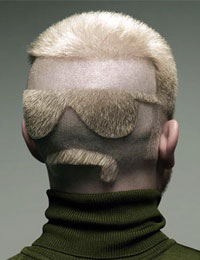Hi, doc. I’ve been researching hair-transplantation, and I have a question concerning F.U.T. (strip-harvesting): I understand, in this method, a strip is excised from the back of the scalp, the wound then closed. I wonder, then, is not the overall surface of the scalp reduced in this procedure? After two or three procedures, especially, (or even after one large session) — when, totally, a reasonably wide portion of the scalp has been removed, will not a patient’s hairline, in accordance, also be shifted?
That is, the front hairline would move back by the amount of scalp excised, or, more likely, the “rear hairline” (which ends at the back of the neck) must certainly be “moved upward.” At least, this is how I imagine it would be. Is my logic flawed? I’ve been trying to understand this in researching the procedure, but the point still evades me.
I understand a physician will take into consideration laxity of the scalp, so what I’m talking about might not be immediately noticed — I also hear doctors will try to cut out strips that are longer rather than wider, to reduce tension — but, ultimately (again, especially when a large number of grafts must be harvested), will not the hairlines (front and certainly rear) be affected? If not, why not? If so, is this effect permanent? The piece of scalp taken out can’t “regenerate,” can it (and, if it could, would it regenerate hair follicles, too)?
Sorry for this long question, but certainly I’d appreciate your taking the time to answer. Thank you very much.
P.S. Just one other question (a brief one): Can hair that’s already been transplanted to a new location be removed and successfully retransplanted in another area (e.g., back to front, then, later, if need be, north of that region)?
The hairline never shifts, but the scalp itself does stretch a little with each procedure so that the donor density reduces a bit. I’ve answered a similar question before.
Neither the front hairline nor the neck hair moves as a result of these excised areas. The only part of the scalp that is impacted is either the posterior scalp (which would be stretched) or in a small group of these patients, the redundancy of the scalp (scalp laxity) reduces. The scalp is attached to the galea and then to the skull. This keeps the movement from one area to another minimal, if at all. Scalp and follicles can’t regenerate.
As for your P.S. — Yes, we often move previously transplanted hair when the work is not good, but there are limitations to moving a great deal of transplanted hair. This is commonly done in repair procedures.
Tags: hair transplant, scalp laxity, hairline, hair loss, hairloss, repair, surgery

 Yep, the ad is requesting participants for a paid research study in Colorado.
Yep, the ad is requesting participants for a paid research study in Colorado. I’m just trying to figure out if I understand what you want to do and what you’re asking me. Perhaps your terminology is off. I have to assume that when you say you want hair transplanted to your “sides” you actually mean the corners of the hairline… not the sides of your head.
I’m just trying to figure out if I understand what you want to do and what you’re asking me. Perhaps your terminology is off. I have to assume that when you say you want hair transplanted to your “sides” you actually mean the corners of the hairline… not the sides of your head. Chronic prostatitis can be a very serious problem and must be treated with supervision from your physician. Some doctors question the use of long term antibiotics if the infection has been successfully treated, but many people with chronic prostatitis have persistent pain that may not reflect an active infection. If your doctor is going to prescribe you ciprofloxacin (an antibiotic also known as Cipro), perhaps he has more experience with possible side effects than I would.
Chronic prostatitis can be a very serious problem and must be treated with supervision from your physician. Some doctors question the use of long term antibiotics if the infection has been successfully treated, but many people with chronic prostatitis have persistent pain that may not reflect an active infection. If your doctor is going to prescribe you ciprofloxacin (an antibiotic also known as Cipro), perhaps he has more experience with possible side effects than I would.